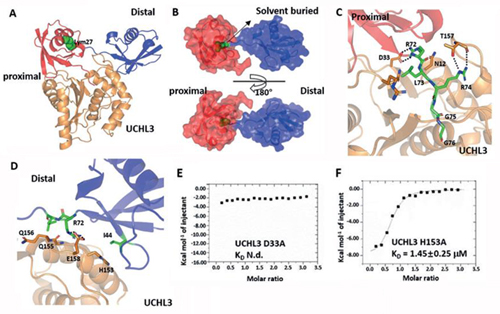Recently, the research group of Ziqing Mei, from the Microbial Protein Engineering group in Biotechnology Research Institute published a paper entitled Chemical Protein Synthesis Enabled Mechanistic Studies on Molecular Recognition of K27-linked Ubiquitin Chains on Angewandte Chemie International Edition journal (the top journal of chemical science, IF 12.102) on February 25, 2019. In this paper, they determined the high-resolution crystal structure of deubiquitinating enzyme UCHL3 complexed with K27 linked di-ubiquitin and provided the insight into the molecular recognition mechanism of K27 linked ubiquitin chains (a new type of "ubiquitin code") by UCHL3. This finding established foundation both for molecular breeding and for the prevention and control of major zoonotic diseases related to the regulation of "ubiquitin code" in signaling pathway.

Figure1. Ubiquitin code: different ubiquitin chains determine different fates of substrates.
Ubiquitin is a small polypeptide that is ubiquitous and highly conserved in eukaryotes. The process of the ubiquitin linking to substrate proteins is called ubiquitination, which is one of the most important post-translational modifications in organisms. It plays a significant regulatory role in various physiological processes from photosynthesis, stress and drought resistance of plants to the invasion of pathogenic microorganisms, such as viruses, pathogens, livestock, poultry as well as host immune defense. The different ubiquitin chains display different dimensional structures, which could confer different physiological regulatory roles on the substrate proteins, which constitutes the "ubiquitin code"(Figure 1).
In recent years, the research on identification and regulatory roles of "ubiquitin code" has become the hotspot and frontier in life science. Among various "ubiquitin code", K27 linked ubiquitin chains are reported to involve in DNA repair, autoimmune system, and some other processes. Due to the lack of biochemical and structural evidence, the molecular mechanism of its recognition and regulation is still elusive, which severely hinders effective intervention on the regulatory pathway involving the K27 ubiquitin chains.
It is the first study on revealing the molecular recognition mechanism of K27 ubiquitin chains by UCHL3. This work characterized the unique structural features of K27 linked di-ubiquitin chains and the conformational changes after recognizing by UCHL3, by combining chemical biology, biophysics and biochemistry to determine the crystal structure of deubiquitinating enzyme UCHL3 complexed with K27 linked di-ubiquitin (Figure 2).

Figure2. Crystal structure of deubiquitinating enzyme UCHL3 complexed with K27 linked di-ubiquitin.
Since joining the Chinese Academy of Agricultural Sciences in 2015, the group of Ziqing Mei and her collaborators have performed a series of work to establish the platform on obtaining ubiquitin chains using chemical synthesis methods, determining the structure and functional characterization. They have successfully determined the structures of several key protein complexes and revealed the molecular mechanism of related life science. This research is the fourth paper published by this group in the ubiquitin-26S proteasome field after the paper published on the proceedings of the National Academy of Sciences of the United States of America in 2016, the Angewandte Chemie International Edition in 2017 and Cell Research in 2018. This work is completed by the Biotechnology Research Institute of Chinese Academy of Agricultural Sciences in cooperation with Tsinghua University. Associate Professor Ziqing Mei from Biotechnology Research Institute, Professor Lei Liu, and Chunlai Chen from Tsinghua University are co-corresponding authors. Shan Ding, a master student at the Biotechnology Research Institute, is the co-first author.
More details are available on the link below:
https://www.ncbi.nlm.nih.gov/pubmed/30589182
By: Mei Ziqing
meiziqing@caas.cn
|